Novel Derivatives of Eugenol as a New Class of PPARγ Agonists in Treating Inflammation: Design, Synthesis, SAR Analysis and In Vitro Anti-Inflammatory Activity
Abstract
1. Introduction
2. Results
2.1. Design of Eugenol Derivatives as PPARγ Agonists
2.2. Synthesis
2.3. ADMET and TOPKAT Profile
2.4. Structure-Based Drug Designing
2.5. Structure–Activity Relationships (SAR)
2.6. Time-Dependent Parameter Conformational Analysis of the Complex
2.7. TR-FRET Assay
2.8. In Vitro Anti-Inflammatory Activity
2.8.1. Albumin Denaturation Assay
2.8.2. HRBC Method
3. Discussion
4. Materials and Methods
4.1. In Silico Studies and Spectral Data Analysis
4.2. General Procedure for the Synthesis of Eugenol Derivatives
- Step-1: Synthesis of substituted 2-chloro-N-phenylacetamide
- Step-2: Coupling eugenol with substituted 2-chloro-N-phenylacetamide
4.3. The Spectral Data of Novel Synthesized Eugenol Derivatives (Supplementary Materials)
4.3.1. 2-(4-Alyl-2-methoxyphenoxy)-N-phenylacetamide (1a)
4.3.2. 2-(4-Allyl-2-methoxyphenoxy)-N-(4-nitrophenyl)acetamide (1b)
4.3.3. 2-(4-Allyl-2-methoxyphenoxy)-N-(o-tolyl)acetamide (1c)
4.3.4. 2-(4-Allyl-2-methoxyphenoxy)-N-[(3-trifluoromethyl)phenyl]acetamide (1d)
4.3.5. 2-(4-Allyl-2-methoxyphenoxy)-N-(3-chlorophenyl)acetamide (1e)
4.3.6. 2-(4-Allyl-2-methoxyphenoxy)-N-(2-chlorophenyl)acetamide (1f)
4.4. ADMET, Drug Likeness and Toxicity Predictions
4.5. Molecular Docking
4.6. Molecular Dynamics Simulation
4.7. TR-FRET Competitive Protein Binding Assay
4.8. Anti-Inflammatory Activity
4.8.1. Albumin Denaturation Assay
4.8.2. HRBC Method
4.9. Statistical Analysis
5. Conclusions
Supplementary Materials
Author Contributions
Funding
Institutional Review Board Statement
Informed Consent Statement
Data Availability Statement
Acknowledgments
Conflicts of Interest
Sample Availability
References
- Belvisi, M.G.; Hele, D.J.; Birrell, M.A. Peroxisome proliferator-activated receptor gamma agonists as therapy for chronic airway inflammation. Eur. J. Pharmacol. 2006, 533, 101–109. [Google Scholar] [CrossRef]
- El-Naa, M.M.; El-Refaei, M.F.; Nasif, W.A.; Abdul Jawad, S.H.; El-Brairy, A.I.; El-Readi, M.Z. In-vivo antioxidant and anti-inflammatory activity of rosiglitazone, a peroxisome proliferator-activated receptor-gamma (PPAR-γ) agonists in animal model of bronchial asthma. J. Pharm. Pharmacol. 2015, 67, 1421–1430. [Google Scholar] [CrossRef] [PubMed]
- Kapadia, R.; Yi, J.H.; Vemuganti, R. Mechanisms of anti-inflammatory and neuroprotective actions of PPAR-gamma agonists. Front. Biosci. 2008, 1, 1813–1826. [Google Scholar] [CrossRef]
- Straus, D.S.; Glass, C.K. Anti-inflammatory actions of PPAR ligands: New insights on cellular and molecular mechanisms. Trends Immunol. 2007, 28, 551–558. [Google Scholar] [CrossRef]
- Villapol, S. Roles of Peroxisome Proliferator-Activated Receptor Gamma on Brain and Peripheral Inflammation. Cell. Mol. Neurobiol. 2018, 38, 121–132. [Google Scholar] [CrossRef]
- Xie, L.-W.; Atanasov, A.G.; Guo, D.-A.; Malainer, C.; Zhang, J.-X.; Zehl, M.; Guan, S.-H.; Heiss, E.H.; Urban, E.; Dirsch, V.M.; et al. Activity-guided isolation of NF-κB inhibitors and PPARγ agonists from the root bark of Lycium chinense Miller. J. Ethnopharmacol. 2014, 152, 470–477. [Google Scholar] [CrossRef] [PubMed]
- Wahli, W.; Michalik, L. PPARs at the crossroads of lipid signaling and inflammation. Trends Endocrinol. Metab. 2012, 23, 351–363. [Google Scholar] [CrossRef]
- Klotz, L.; Burgdorf, S.; Dani, I.; Saijo, K.; Flossdorf, J.; Hucke, S.; Alferink, J.; Novak, N.; Beyer, M.; Mayer, G.; et al. The nuclear receptor PPAR gamma selectively inhibits Th17 differentiation in a T cell-intrinsic fashion and suppresses CNS autoimmunity. J. Exp. Med. 2009, 206, 2079–2789. [Google Scholar] [CrossRef] [PubMed]
- Anjum, N.F.; Purohit, M.N.; Yogish Kumar, H.; Ramya, K.; Javid, S.; Salahuddin, M.D.; Prashantha Kumar, B.R. Semisynthetic Derivatives of Eugenol and their Biological Properties: A Fleeting Look at the Promising Molecules. J. Biol. Act. Prod. Nat. 2020, 10, 379–404. [Google Scholar] [CrossRef]
- Abdou, A.; Elmakssoudi, A.; El Amrani, A.; JamalEddine, J.; Dakir, M. Recent advances in chemical reactivity and biological activities of eugenol derivatives. Med. Chem. Res. 2021, 30, 1011–1030. [Google Scholar] [CrossRef]
- Rojo, L.; Vazquez, B.; Parra, J.; López Bravo, A.; Deb, S.; San Roman, J. From natural products to polymeric derivatives of “eugenol”: A new approach for preparation of dental composites and orthopedic bone cements. Biomacromolecules 2006, 7, 2751–2761. [Google Scholar] [CrossRef] [PubMed]
- Gulcin, I. Antioxidant activity of eugenol: A structure-activity relationship study. J. Med. Food 2011, 14, 975–985. [Google Scholar] [CrossRef] [PubMed]
- da Silva, F.F.M.; Monte, F.J.Q.; de Lemos, T.L.G.; do Nascimento, P.G.G.; de Medeiros Costa, A.; de Paiva, L.M.M. Eugenol derivatives: Synthesis, characterization, and evaluation of antibacterial and antioxidant activities. Chem. Cent. J. 2018, 12, 34. [Google Scholar] [CrossRef]
- Rohane, S.H.; Chauhan, A.J.; Fuloria, N.K.; Fuloria, S. Synthesis and in vitro antimycobacterial potential of novel hydrazones of eugenol. Arab. J. Chem. 2020, 13, 4495–4504. [Google Scholar] [CrossRef]
- Jaganathan, S.K.; Supriyanto, E. Antiproliferative and molecular mechanism of eugenol-induced apoptosis in cancer cells. Molecules 2012, 17, 6290–6304. [Google Scholar] [CrossRef]
- Xie, Y.; Huang, Q.; Wang, Z.; Cao, H.; Zhang, D. Structure-activity relationships of cinnamaldehyde and eugenol derivatives against plant pathogenic fungi. Ind. Crop. Prod. 2017, 97, 388–394. [Google Scholar] [CrossRef]
- Zhang, P.; Zhang, E.; Xiao, M.; Chen, C.; Xu, W. Study of anti-inflammatory activities of α-d-glucosylated eugenol. Arch. Pharm. Res. 2013, 36, 109–115. [Google Scholar] [CrossRef]
- Pramod, K.; Ansari, S.H.; Ali, J. Eugenol: A natural compound with versatile pharmacological actions. Nat. Prod. Commun. 2010, 5, 1999–2006. [Google Scholar] [CrossRef]
- Chniguir, A.; Pintard, C.; Liu, D.; Dang, P.M.C.; El-Benna, J.; Bachoual, R. Eugenol prevents fMLF-induced superoxide anion production in human neutrophils by inhibiting ERK1/2 signaling pathway and p47phox phosphorylation. Sci. Rep. 2019, 9, 18540. [Google Scholar] [CrossRef]
- Deepak, V.; Kasonga, A.; Kruger, M.C.; Coetzee, M. Inhibitory effects of eugenol on RANKL-induced osteoclast formation via attenuation of NF-κB and MAPK pathways. Connect. Tissue Res. 2015, 56, 195–203. [Google Scholar] [CrossRef]
- Prashantha Kumar, B.R.; Baig, N.R.; Sudhir, S.; Kar, K.; Kiranmai, M.; Pankaj, M.; Joghee, N.M. Discovery of novel glitazones incorporated with phenylalanine and tyrosine: Synthesis, antidiabetic activity and structure-activity relationships. Bioorg. Chem. 2012, 45, 12–28. [Google Scholar] [CrossRef]
- Daina, A.; Michielin, O.; Zoete, V. SwissADME: A free web tool to evaluate pharmacokinetics, drug-likeness and medicinal chemistry friendliness of small molecules. Sci. Rep. 2017, 7, 42717. [Google Scholar] [CrossRef]
- Lipinski, C.A. Drug-like properties and the causes of poor solubility and poor permeability. J. Pharmacol. Toxicol. Methods 2000, 44, 235–249. [Google Scholar] [CrossRef]
- Lipinski, C.A.; Lombardo, F.; Dominy, B.W.; Feeney, P.J. Experimental and computational approaches to estimate solubility and permeability in drug discovery and development settings. Adv. Drug Deliv. Rev. 2012, 64, 4–17. [Google Scholar] [CrossRef]
- Tirado-Rives, J.; Jorgensen, W.L. Contribution of conformer focusing to the uncertainty in predicting free energies for protein-ligand binding. J. Med. Chem. 2006, 49, 5880–5884. [Google Scholar] [CrossRef] [PubMed]
- Ferreira, L.G.; Dos Santos, R.N.; Oliva, G.; Andricopulo, A.D. Molecular docking and structure-based drug design strategies. Molecules 2015, 20, 13384–13421. [Google Scholar] [CrossRef] [PubMed]
- Guha, R. On exploring structure-activity relationships. Methods Mol. Biol. 2013, 993, 81–94. [Google Scholar] [CrossRef]
- Martinez-Gonzalez, A.I.; Díaz-Sánchez, Á.G.; De La Rosa, L.A.; Bustos-Jaimes, I.; Alvarez-Parrilla, E.J. Inhibition of α-amylase by flavonoids: Structure activity relationship (SAR). Spectro. Acta Part A Mol. Biomol. Spectro. 2019, 206, 437–447. [Google Scholar] [CrossRef]
- Maiorov, V.N.; Crippen, G.M. Significance of root-mean-square deviation in comparing three-dimensional structures of globular proteins. J. Mol. Biol. 1994, 235, 625–634. [Google Scholar] [CrossRef]
- Lobanov, M.Y.; Bogatyreva, N.S.; Galzitskaya, O.V. Radius of gyration as an indicator of protein structure compactness. Mol. Biol. 2008, 42, 623–628. [Google Scholar] [CrossRef]
- Mosure, S.A.; Shang, J.; Eberhardt, J.; Brust, R.; Zheng, J.; Griffin, P.R.; Forli, S.; Kojetin, D.J. Structural Basis of Altered Potency and Efficacy Displayed by a Major in Vivo Metabolite of the Antidiabetic PPARγ Drug Pioglitazone. J. Med. Chem. 2019, 62, 2008–2223. [Google Scholar] [CrossRef]
- Kumar, A.P.; Mandal, S.; Prabitha, P.; Faizan, S.; Prashantha Kumar, B.R.; Dhanabal, S.P.; Justin, A. Rational design, molecular docking, dynamic simulation, synthesis, PPAR-γ competitive binding and transcription analysis of novel glitazones. J. Mol. Struct. 2022, 1265, 133354. [Google Scholar] [CrossRef]
- Sivamani, Y.; Shanmugarajan, D.; Kumar, T.D.; Faizan, S.; Channappa, B.; Naishima, N.L.; Prashantha Kumar, B.R. A promising in silico protocol to develop novel PPARγ antagonists as potential anticancer agents: Design, synthesis and experimental validation via PPARγ protein activity and competitive binding assay. Comp. Biol. Chem. 2021, 95, 107600. [Google Scholar] [CrossRef] [PubMed]
- Moualek, I.; Iratni Aiche, G.; Mestar Guechaoui, N.; Lahcene, S.; Houali, K. Antioxidant and anti-inflammatory activities of Arbutus unedo aqueous extract. Asian Pac. J. Trop. Biomed. 2016, 6, 937–944. [Google Scholar] [CrossRef]
- Ruiz-Ruiz, J.C.; Matus-Basto, A.J.; Acereto-Escoffié, P.; Segura-Campos, M.R. Antioxidant and anti-inflammatory activities of phenolic compounds isolated from Melipona beecheii honey. Food Agric. Immunol. 2017, 28, 1424–1437. [Google Scholar] [CrossRef]
- Naveed, M.; Batool, H.; Rehman, S.u.; Javed, A.; Makhdoom, S.I.; Aziz, T.; Mohamed, A.A.; Sameeh, M.Y.; Alruways, M.W.; Dablool, A.S.; et al. Characterization and evaluation of the antioxidant, antidiabetic, anti-inflammatory, and cytotoxic activities of silver nanoparticles synthesized using Brachychiton populneus leaf extract. Processes 2022, 10, 1521. [Google Scholar] [CrossRef]
- Bhosale, M.; Yadav, A.; Magdum, C.; Mohite, S. Molecular Docking Studies, Synthesis, Toxicological Evaluation using Brine Shrimp (Artemia salina L.) Model and Anti-inflammatory Activity of Some N-(substituted)-5-phenyl-1, 3, 4-thiadiazol-2-amine Derivatives. Int. J. Sci. Res. Sci. Technol. 2020, 7, 51–62. [Google Scholar] [CrossRef]
- Porchezhiyan, V.; Kalaivani, D.; Shobana, J.; Noorjahan, S.E. Synthesis, docking and in vitro evaluation of L-proline derived 1, 3-diketones possessing anti-cancer and anti-inflammatory activities. J. Mol. Struct. 2020, 1206, 127754. [Google Scholar] [CrossRef]
- Naik, M.D.; Bodke, Y.D.; Prashantha, J.; Naik, J.K. A facile one-pot synthesis of 1H-pyrano [2,3-d] pyrimidin-4 (5H)-ones and evaluation of their Ct-DNA interaction, antibacterial and anti-inflammatory activity. J. Chem. Sci. 2021, 133, 17. [Google Scholar] [CrossRef]
- Anjum, N.F.; Shanmugarajan, D.; Shivaraju, V.K.; Faizan, S.; Naishima, N.L.; Prashantha Kumar, B.R.; Javid, S.; Purohit, M.N. Novel derivatives of eugenol as potent anti-inflammatory agents via PPARγ agonism: Rational design, synthesis, analysis, PPARγ protein binding assay and computational studies. RSC Adv. 2022, 12, 16966–16978. [Google Scholar] [CrossRef]
- Mizushima, Y.; Sakai, S.; Yamaura, M. Mode of stabilizing action of non-steroid anti-inflammatory drugs on erythrocyte membrane. Biochem. Pharmacol. 1970, 19, 227–234. [Google Scholar] [CrossRef] [PubMed]
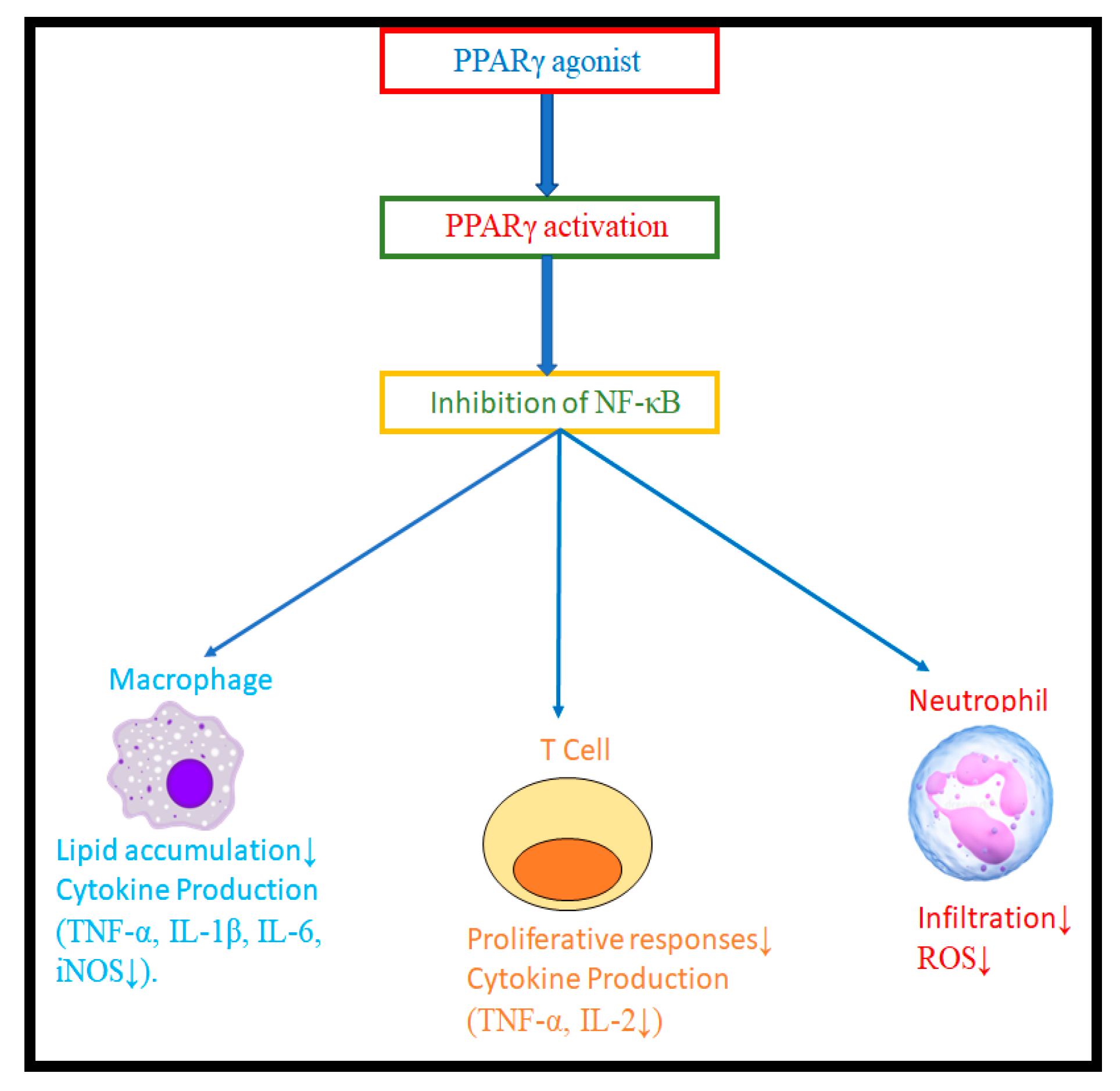
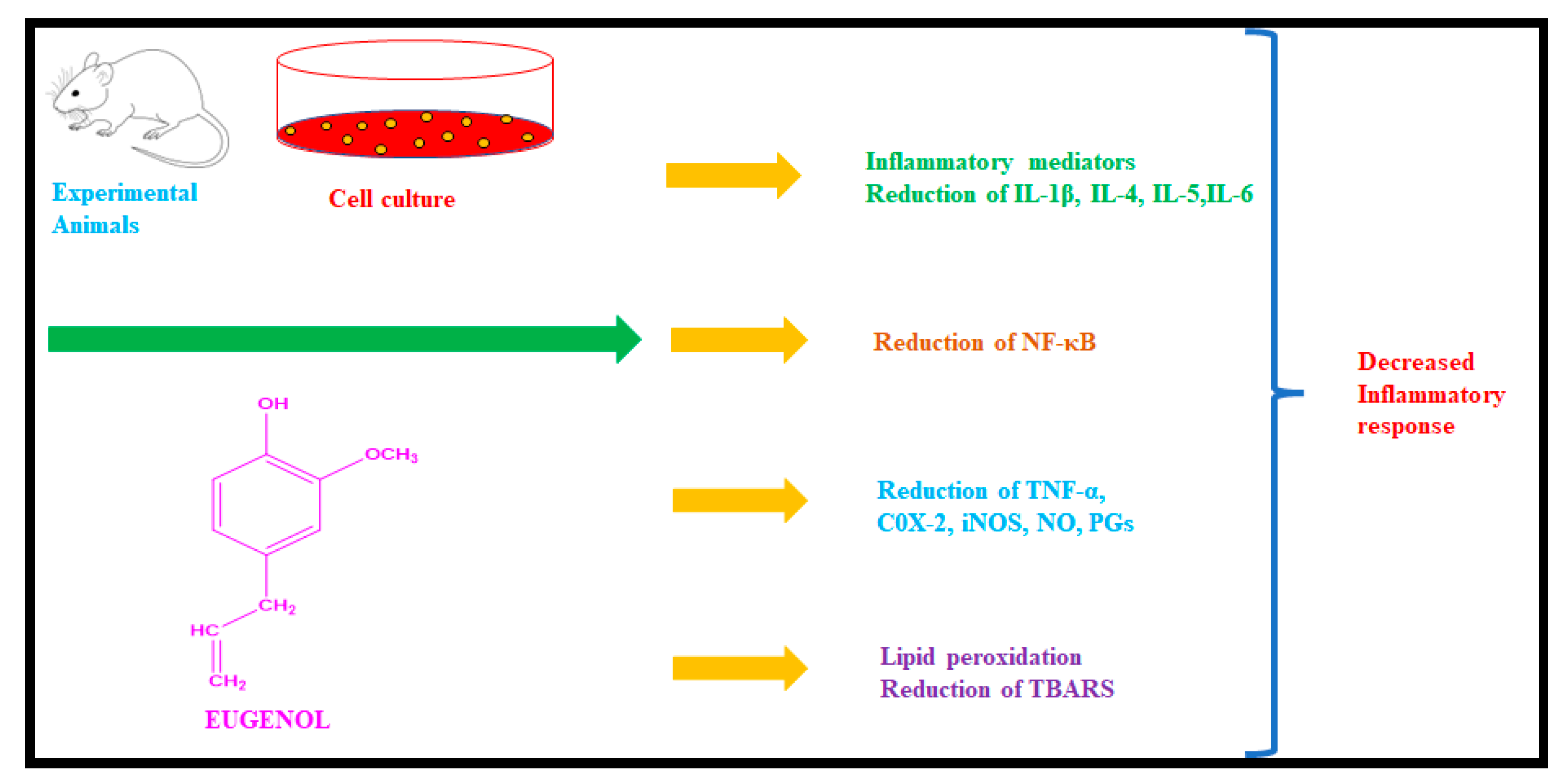
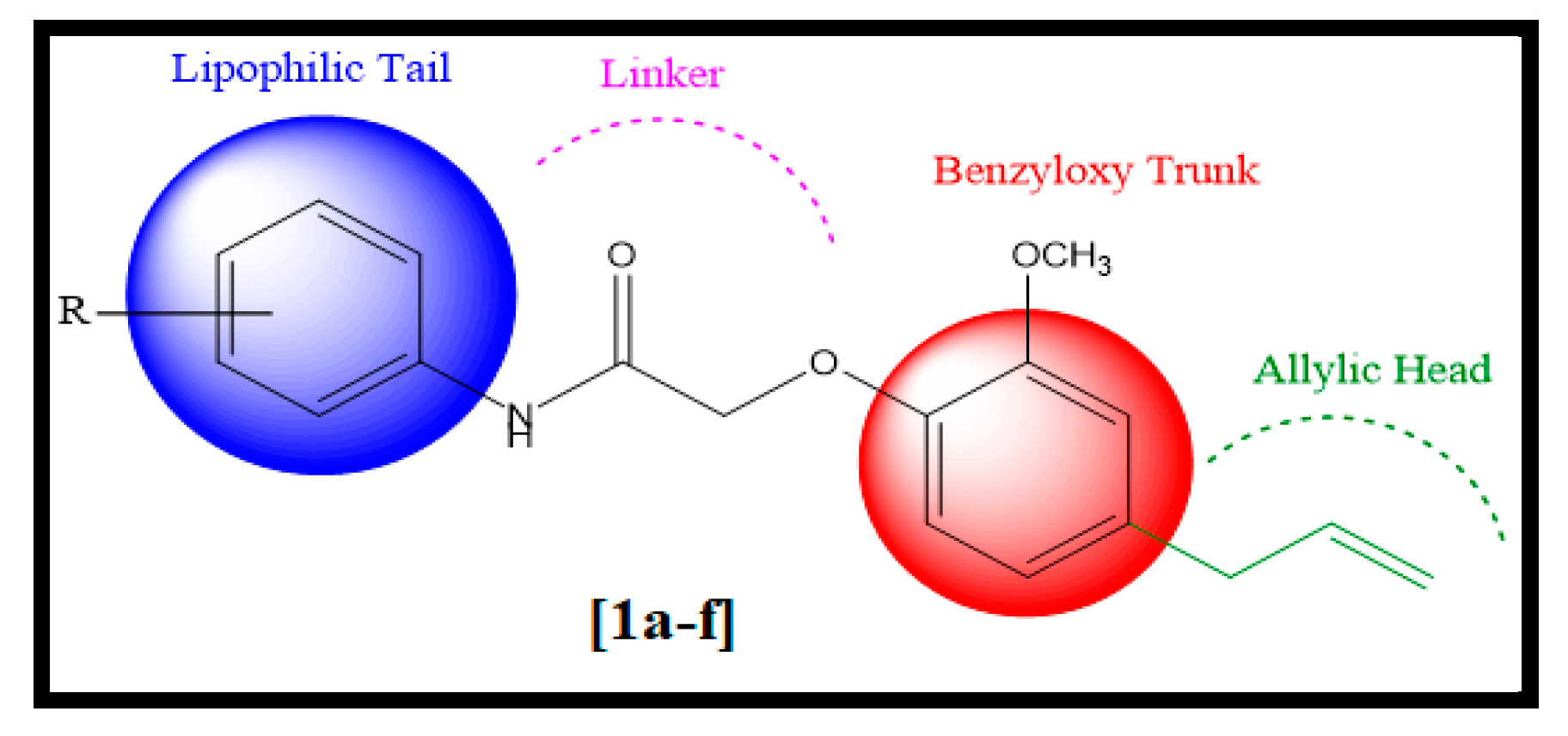

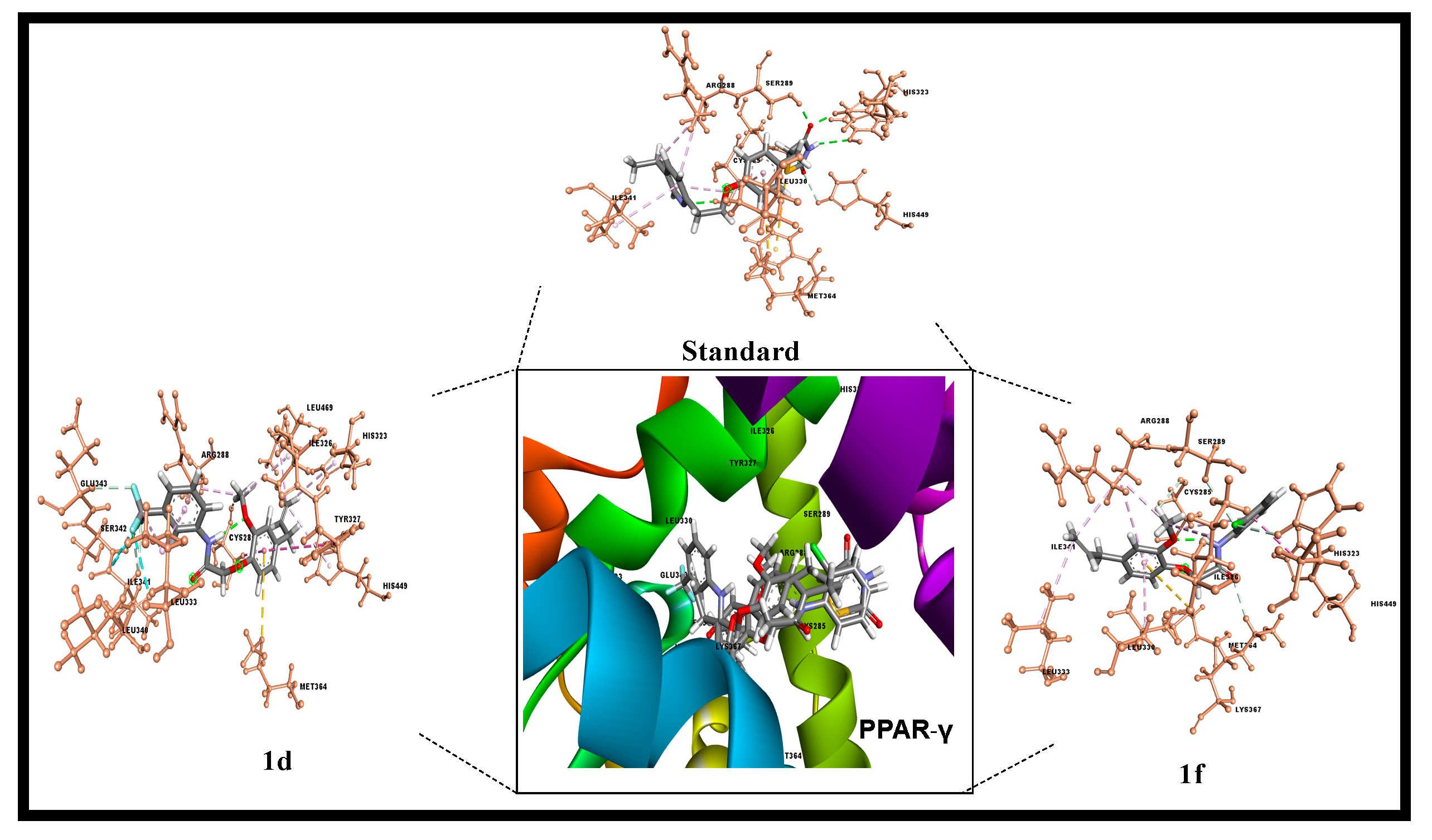
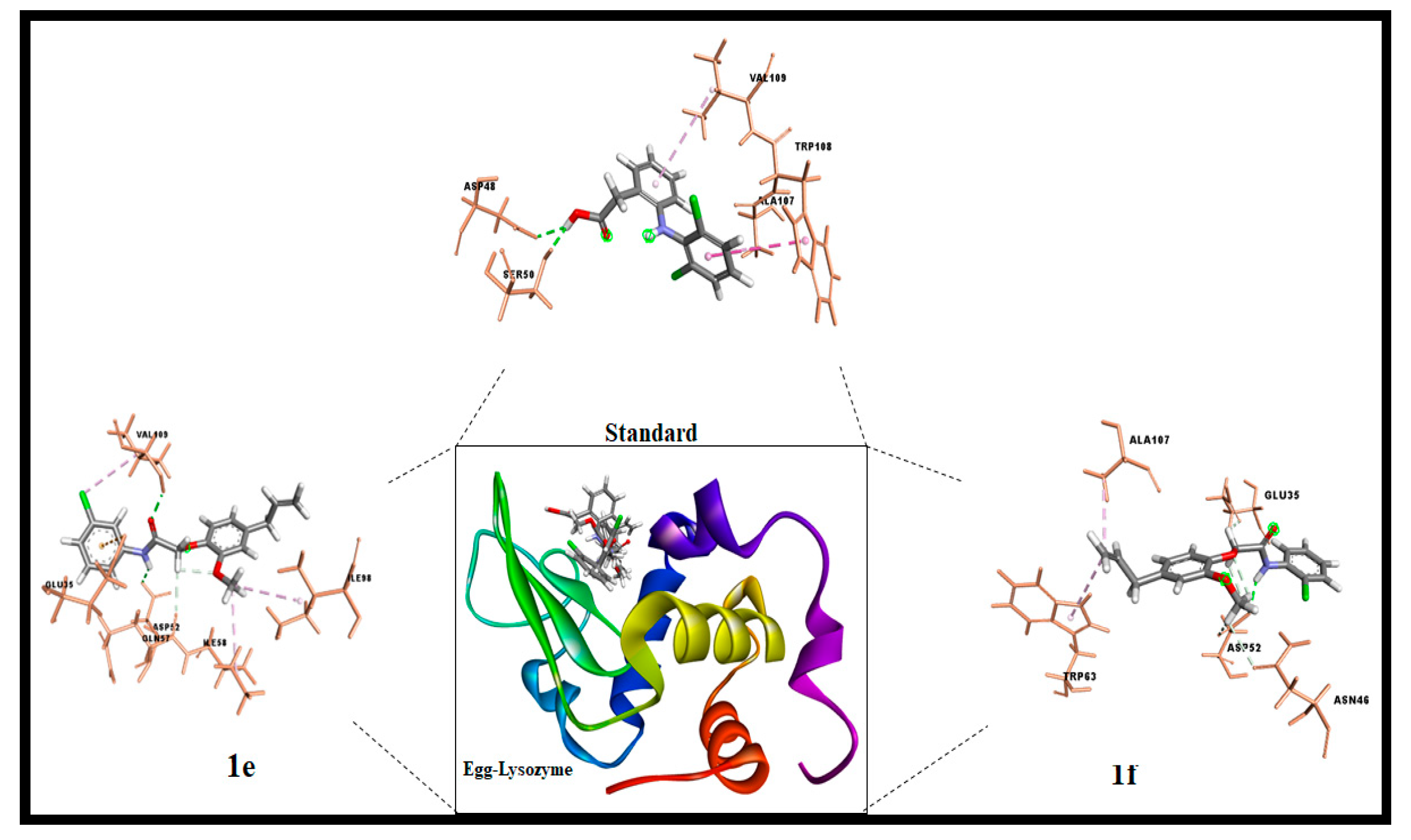
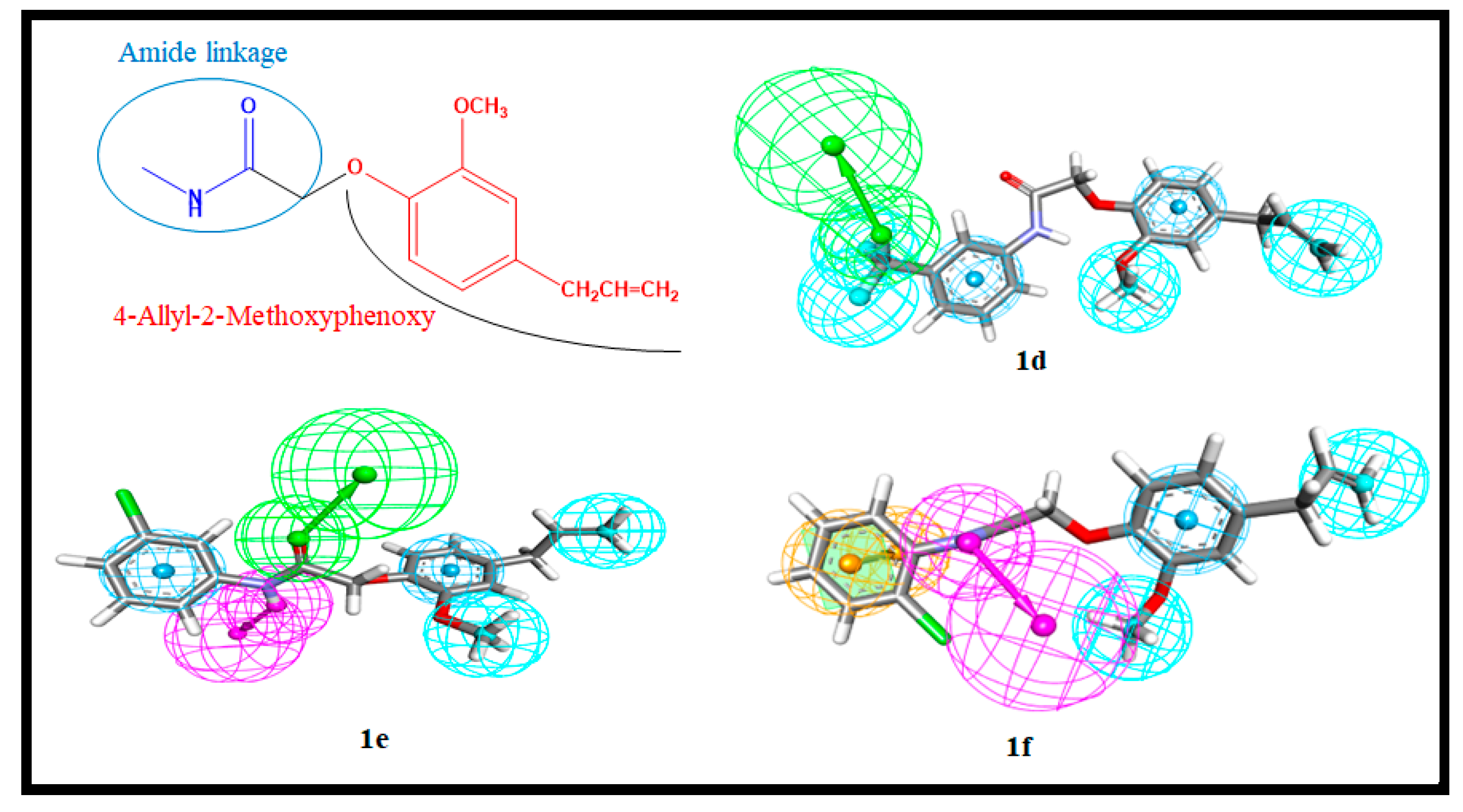
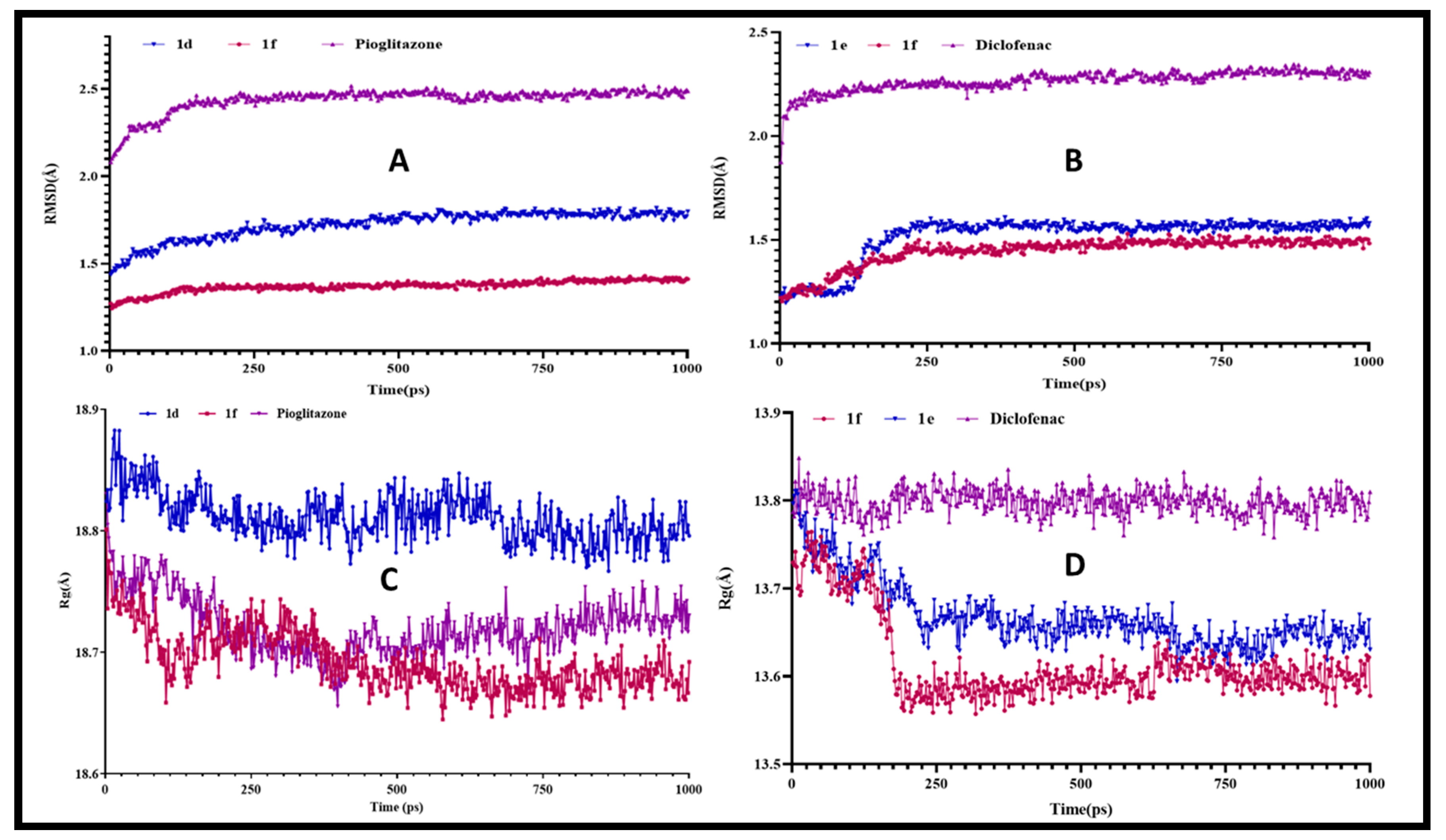
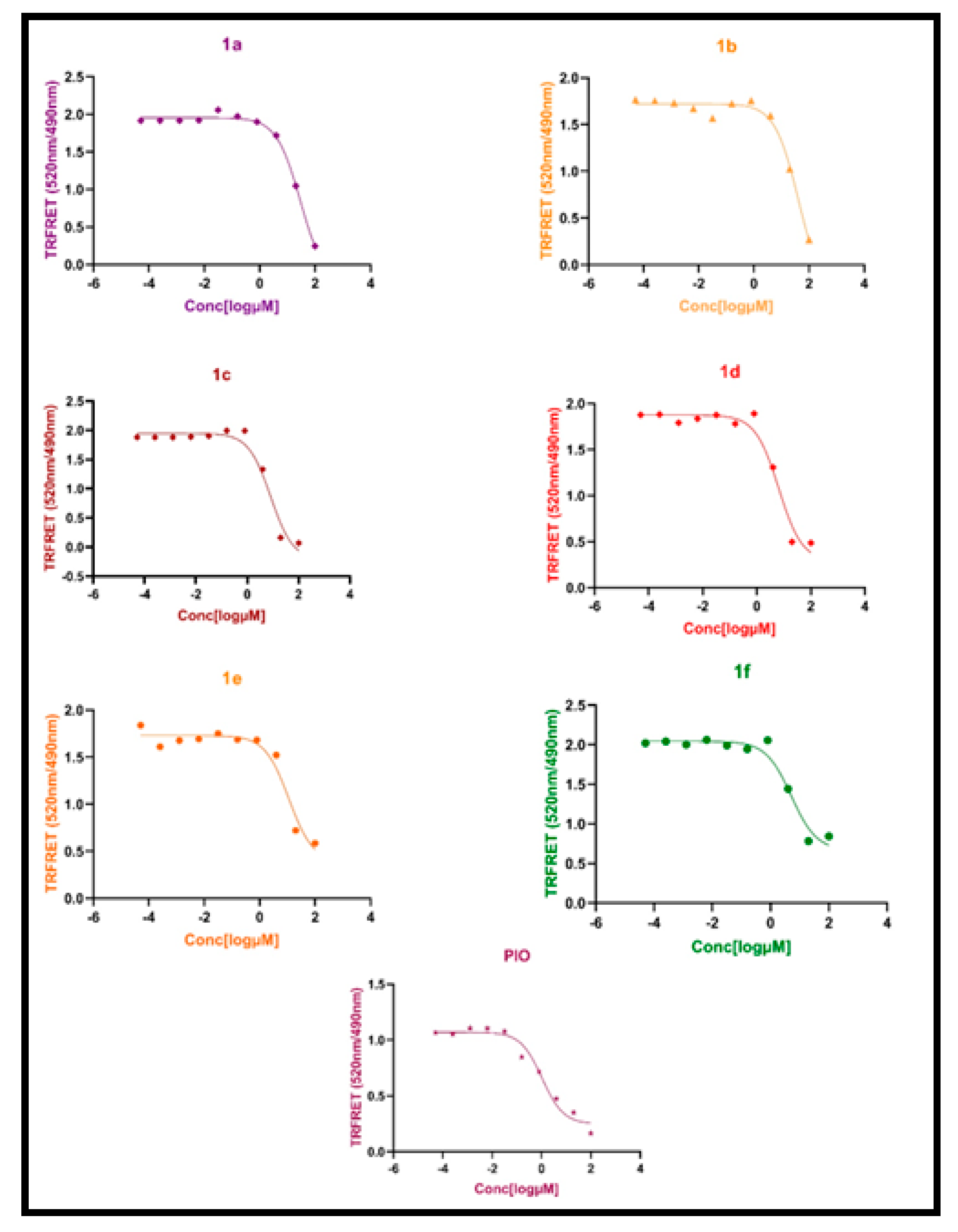
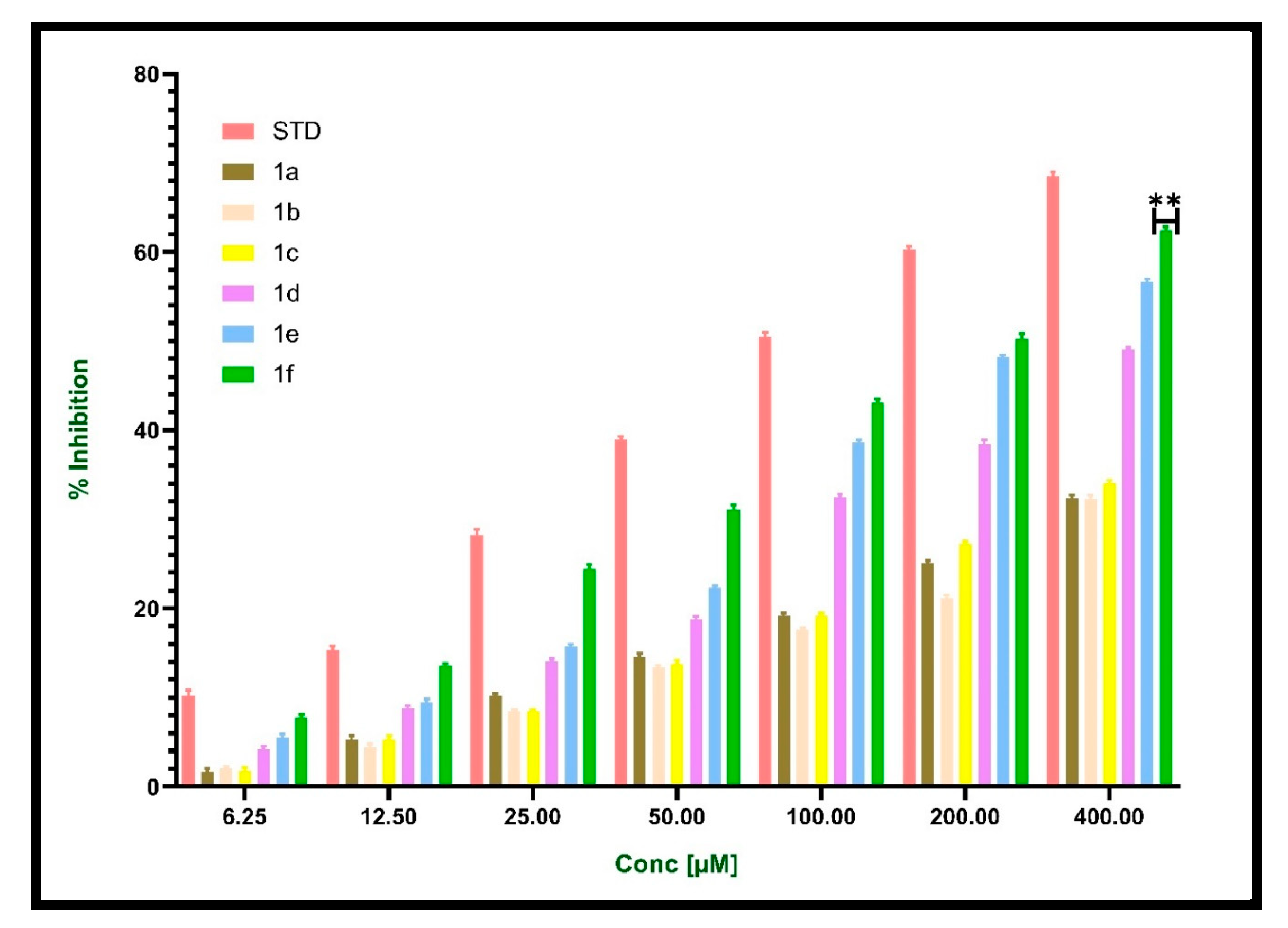
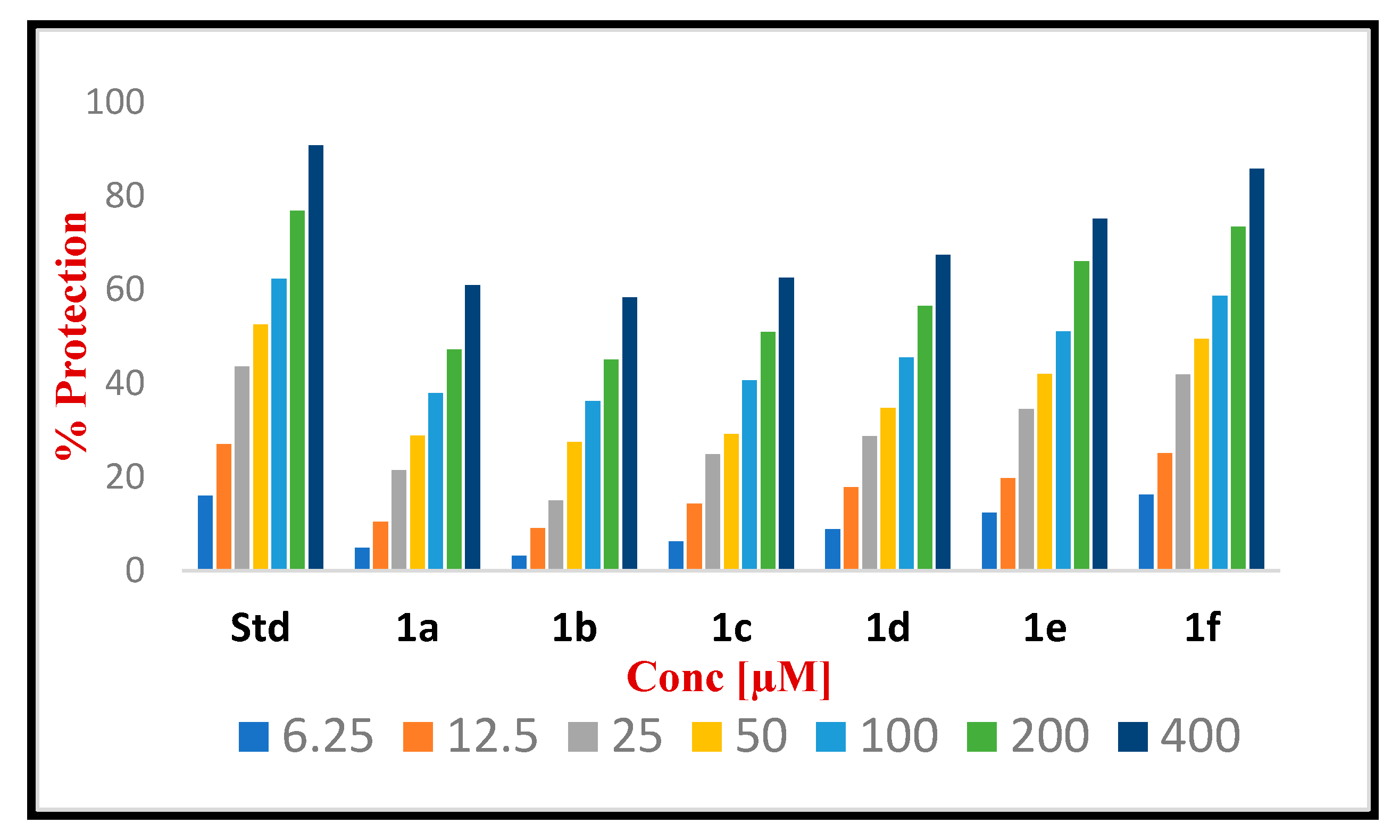
| Compound Name | Solubility | BBB | CPY2D6 | HIA | NTP_RAT | Ames Mutagen | |
|---|---|---|---|---|---|---|---|
| Male | Female | ||||||
| 1a | 3 | 1 | NI | 0 | NC | NC | NM |
| 1b | 3 | 3 | NI | 0 | NC | NC | NM |
| 1c | 2 | 1 | NI | 0 | NC | NC | NM |
| 1d | 2 | 1 | NI | 0 | NC | NC | NM |
| 1e | 2 | 1 | NI | 0 | NC | NC | NM |
| 1f | 2 | 1 | NI | 0 | NC | NC | NM |
| Std | 2 | 1 | NI | 0 | NC | NC | NM |
| Compound Name | Alogp | MW | HBA | HBD | Rat_Oral LD50 g/kg_Body_Weight | Rat_Inhalational LC50 mg/m3/h | Carcinogenic Potency TD50_Rat mg/kg_Body_Weight/day |
|---|---|---|---|---|---|---|---|
| 1a | 3.44 | 297.34 | 3 | 1 | 3.81 | 9659.63 | 329.70 |
| 1b | 3.33 | 342.34 | 7 | 1 | 2.63 | 5797.71 | 54.64 |
| 1c | 3.92 | 311.37 | 4 | 1 | 1.50 | 10,394.00 | 118.84 |
| 1d | 4.38 | 365.34 | 4 | 1 | 2.13 | 35,981.60 | 98.84 |
| 1e | 4.10 | 331.79 | 4 | 1 | 2.56 | 6764.91 | 90.62 |
| 1f | 4.10 | 331.79 | 4 | 1 | 3.33 | 7232.83 | 90.62 |
| Pioglitazone | 3.90 | 356.43 | 5 | 1 | 7.28 | 6054.58 | 61.73 |
| Compound Name | —CDOCKER Energy | Binding Energy | ||
|---|---|---|---|---|
| PPAR-Gamma | Anti-Inflammatory | PPAR-Gamma | Anti-Inflammatory | |
| 1a | 19.56 | 15.14 | −1.01 | −0.92 |
| 1b | 19.39 | 14.37 | −1.59 | −789 |
| 1c | 22.50 | 15.51 | −1.32 | −0.95 |
| 1d | 23.81 | 16.39 | −15.97 | −1.00 |
| 1e | 21.98 | 18.14 | −5.94 | −1.32 |
| 1f | 24.13 | 18.32 | −20.88 | −2.67 |
| Std | 37.15 | 23.11 | −12.58 | −2.01 |
| Energy Parameters | PPARγ | Inflammatory | ||||
|---|---|---|---|---|---|---|
| 1f | 1d | Pioglitazone | 1f | 1e | Diclofenac | |
| Potential | −16,722 ± 160.70 | −16,424 ± 110.10 | −16,681 ± 128.70 | −7490 ± 104.10 | −7309 ± 82.44 | −7454 ± 39.93 |
| Kinetic | 3324 ± 33.47 | 3324 ± 32.07 | 3326 ± 34.97 | 1498 ± 21.84 | 1499 ± 21.92 | 1488 ± 20.59 |
| Electrostatic | −20,068 ± 174.00 | −19,731 ± 120.70 | −19,930 ± 121.60 | −8988 ± 123.10 | −8803 ± 89.41 | −8909 ± 39.20 |
| Van der Waals | −1666 ± 26.59 | −1644 ± 27.00 | −1623 ± 26.76 | −721.2 ± 17.58 | −719.7 ± 18.73 | −734.7 ± 17.77 |
| Sl. No. | Compound Name | IC50 (µM) |
|---|---|---|
| 1 | Pioglitazone | 1.77 |
| 2 | 1a | 29.83 |
| 3 | 1b | 42.37 |
| 4 | 1c | 8.20 |
| 5 | 1d | 6.47 |
| 6 | 1e | 11.45 |
| 7 | 1f | 5.15 |
| Concentration in [µM] | Standard Diclofenac | 1a | 1b | 1c | 1d | 1e | 1f |
|---|---|---|---|---|---|---|---|
| 6.25 | 10.25 ± 0.55 | 1.67 ± 0.37 | 2.06 ± 0.17 | 1.77 ± 0.37 | 4.21 ± 0.37 | 5.487 ± 0.43 | 7.74 ± 0.34 |
| 12.5 | 15.35 ± 0.43 | 5.32 ± 0.37 | 4.44 ± 0.36 | 5.32 ± 0.37 | 8.79 ± 0.32 | 9.47 ± 0.39 | 13.59 ± 0.23 |
| 25 | 28.22 ± 0.61 | 10.19 ± 0.24 | 8.42 ± 0.24 | 8.42 ± 0.24 | 14.04 ± 0.31 | 15.73 ± 0.24 | 24.42 ± 0.48 |
| 50 | 38.93 ± 0.37 | 14.54 ± 0.43 | 13.37 ± 0.24 | 13.79 ± 0.43 | 18.75 ± 0.39 | 22.35 ± 0.18 | 31.04 ± 0.55 |
| 100 | 49.46 ± 0.51 | 19.20 ± 0.24 | 17.62 ± 0.18 | 19.20 ± 0.24 | 32.46 ± 0.32 | 38.61 ± 0.30 | 43.08 ± 0.43 |
| 200 | 60.29 ± 0.36 | 25.07 ± 0.31 | 21.19 ± 0.30 | 27.26 ± 0.24 | 38.49 ± 0.37 | 48.21 ± 0.18 | 50.22 ± 0.60 |
| 400 | 68.54 ± 0.43 | 32.34 ± 0.37 | 32.24 ± 0.40 | 34.03 ± 0.31 | 49.09 ± 0.18 | 56.62 ± 0.37 | 62.41 ± 0.42 |
| Compounds | IC50 Values in [µM] |
|---|---|
| Standard Diclofenac | 56.03 |
| 1a | 134.00 |
| 1b | 294.31 |
| 1c | 123.10 |
| 1d | 106.81 |
| 1e | 96.23 |
| 1f | 67.02 |
| Concentration [µM] | Standard Diclofenac | 1a | 1b | 1c | 1d | 1e | 1f |
|---|---|---|---|---|---|---|---|
| 6.25 | 15.99 ± 0.64 | 4.79 ± 0.48 | 3.19 ± 0.28 | 6.21 ± 0.38 | 8.85 ± 0.36 | 12.36 ± 0.48 | 15.17 ± 0.64 |
| 12.5 | 26.93 ± 0.55 | 10.45 ± 0.38 | 9.10 ± 0.28 | 14.26 ± 0.38 | 17.77 ± 0.46 | 19.68 ± 0.38 | 25.09 ± 0.66 |
| 25 | 43.54 ± 0.48 | 21.40 ± 0.36 | 15.55 ± 0.28 | 24.78 ± 0.38 | 28.72 ± 0.46 | 34.50 ± 0.36 | 41.88 ± 0.55 |
| 50 | 52.58 ± 0.48 | 28.78 ± 0.66 | 27.49 ± 0.36 | 29.08 ± 0.46 | 34.74 ± 0.56 | 42.00 ± 0.56 | 49.50 ± 0.46 |
| 100 | 62.30 ± 0.59 | 37.88 ± 0.28 | 36.16 ± 0.48 | 40.65 ± 0.28 | 45.51 ± 0.28 | 51.04 ± 0.46 | 58.61 ± 0.38 |
| 200 | 76.87 ± 0.64 | 47.23 ± 0.48 | 45.07 ± 0.28 | 50.92 ± 0.48 | 56.45 ± 0.31 | 66.05 ± 0.36 | 73.43 ± 0.36 |
| 400 | 90.77 ± 0.36 | 60.88 ± 0.36 | 58.36 ± 0.28 | 62.54 ± 0.36 | 67.40 ± 0.28 | 75.09 ± 0.36 | 85.79 ± 0.18 |
| Compounds | IC50 Values in [µM] |
|---|---|
| Standard Diclofenac | 48.14 |
| 1a | 79.50 |
| 1b | 83.15 |
| 1c | 79.70 |
| 1d | 66.30 |
| 1e | 58.15 |
| 1f | 54.97 |
| Compound | Chemical Structure | Mol. wt | Mol. Formula | Rf Value | % Yield |
|---|---|---|---|---|---|
| 1a |  | 297.35 | C18H19NO3 | 0.72 | 80.00 |
| 1b |  | 342.35 | C18H18N2O5 | 0.65 | 75.30 |
| 1c |  | 311.38 | C19H21NO3 | 0.60 | 80.50 |
| 1d |  | 365.35 | C19H18F3NO3 | 0.62 | 70.80 |
| 1e |  | 331.79 | C18H18ClNO3 | 0.65 | 77.60 |
| 1f |  | 331.79 | C18H18ClNO3 | 0.64 | 87.90 |
Disclaimer/Publisher’s Note: The statements, opinions and data contained in all publications are solely those of the individual author(s) and contributor(s) and not of MDPI and/or the editor(s). MDPI and/or the editor(s) disclaim responsibility for any injury to people or property resulting from any ideas, methods, instructions or products referred to in the content. |
© 2023 by the authors. Licensee MDPI, Basel, Switzerland. This article is an open access article distributed under the terms and conditions of the Creative Commons Attribution (CC BY) license (https://creativecommons.org/licenses/by/4.0/).
Share and Cite
Anjum, N.F.; Shanmugarajan, D.; Prashantha Kumar, B.R.; Faizan, S.; Durai, P.; Raju, R.M.; Javid, S.; Purohit, M.N. Novel Derivatives of Eugenol as a New Class of PPARγ Agonists in Treating Inflammation: Design, Synthesis, SAR Analysis and In Vitro Anti-Inflammatory Activity. Molecules 2023, 28, 3899. https://doi.org/10.3390/molecules28093899
Anjum NF, Shanmugarajan D, Prashantha Kumar BR, Faizan S, Durai P, Raju RM, Javid S, Purohit MN. Novel Derivatives of Eugenol as a New Class of PPARγ Agonists in Treating Inflammation: Design, Synthesis, SAR Analysis and In Vitro Anti-Inflammatory Activity. Molecules. 2023; 28(9):3899. https://doi.org/10.3390/molecules28093899
Chicago/Turabian StyleAnjum, Noor Fathima, Dhivya Shanmugarajan, B. R. Prashantha Kumar, Syed Faizan, Priya Durai, Ruby Mariam Raju, Saleem Javid, and Madhusudan N. Purohit. 2023. "Novel Derivatives of Eugenol as a New Class of PPARγ Agonists in Treating Inflammation: Design, Synthesis, SAR Analysis and In Vitro Anti-Inflammatory Activity" Molecules 28, no. 9: 3899. https://doi.org/10.3390/molecules28093899
APA StyleAnjum, N. F., Shanmugarajan, D., Prashantha Kumar, B. R., Faizan, S., Durai, P., Raju, R. M., Javid, S., & Purohit, M. N. (2023). Novel Derivatives of Eugenol as a New Class of PPARγ Agonists in Treating Inflammation: Design, Synthesis, SAR Analysis and In Vitro Anti-Inflammatory Activity. Molecules, 28(9), 3899. https://doi.org/10.3390/molecules28093899






